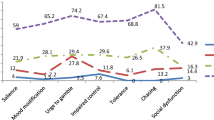Abstract
Across two studies we assessed the clinical utility of the Canadian Problem Gambling Index (CPGI). In Study 1, the scored items on the CPGI significantly correlated with those of the South Oaks Gambling Screen (SOGS), yet their shared variance was low. Importantly, clinician evaluation of the client’s level of pathology was more strongly associated with that revealed by the CPGI than the SOGS. In terms of utility, clinicians found the non-scored items on the CPGI more useful in treatment than those included with the SOGS. In Study 2, the effectiveness of the CPGI profiler (CPGI-P) software, which graphically depicts problematic gambling-relevant attitudes and behaviours, was assessed. Although clients had difficulties using the CPGI-P interface, they overwhelmingly indicated that the output prompted action to address their gambling. The clinicians were less enthusiastic as they felt the output did not help clients truly understand their gambling problems. Such sentiments were reiterated by the clinicians at a 6 months follow-up. The use of the SOGS and possible adoption of the CPGI (as well as the CPGI-P) in a clinical setting are discussed.

Similar content being viewed by others
References
Abbott, M. W., & Volberg, R. A. (2006). The measurement of adult problem and pathological gambling. International Gambling Studies, 6(2), 175–200.
Aegisdottir, S., White, M. J., Spengler, P. M., Maugheman, A. S., Anderson, L. A., Cook, R. S., et al. (2006). The meta-analysis of clinical judgment project: Fifty-six years of accumulated research on clinical versus statistical prediction. The Counseling Psychologist, 34(3), 341–382.
Arthur, D., Tong, W. L., Chen, C. P., Hing, A. Y., Sagara-Rosemeyer, M., Kua, E. H., et al. (2008). The validity and reliability of four measures of gambling behaviour in a sample of Singapore University Students. Journal of Gambling Studies, 24, 451–462.
Battersby, M., Thomas, L. J., Tolchard, B., & Esterman, A. (2002). The South Oaks Gambling Screen: A review with reference to Australian use. Journal of Gambling Studies, 18(3), 257–271.
Cox, B. J., Yu, N., Afifi, T. O., & Ladouceur, R. (2005). A national survey of gambling problems in Canada. Canadian Journal of Psychiatry, 50(4), 213–217.
Dawes, D. M., Faust, D., & Meehl, P. E. (1989). Clinical versus actuarial judgment. Science, 243(4899), 1668–1674.
Duvarci, I., Varan, A., Coskunol, H., & Ersoy, M. A. (1997). DSM-IV and the South Oaks Gambling Screen: Diagnosing and assessing pathological Gambling in Turkey. Journal of Gambling Studies, 13(3), 193–206.
Epstein, J., & McGaha, A. C. (1999). ATOD-TV: Evaluation of a multimedia program designed to educate the public about substance abuse. Computers in Human Behaviour, 15, 73–83.
Ferris, J., & Wynne, H. (2001). The Canadian problem gambling index: Final report. Ottawa: Canadian Centre on Substance Abuse.
Focal Research Consultants. (2001). Survey of gambling and problem gambling in New Brunswick. New Brunswick Department of Health and Wellness.
Franklin, J., & Thomas, D. R. (1989). Clinical observations of family members of compulsive gamblers. In H. J. Shaffer, S. A. Stein, B. Gambino, & T. N. Cummings (Eds.), Compulsive gambling: Theory, research, and practice (pp. 135–146). Lexington, MA: Lexington Books.
Gambino, B., & Lesieur, H. (2006). The South Oaks Gambling Screen (SOGS): A rebuttal to critics. Journal of Gambling Issues, 17, 1–16.
Kavli, H., & Berntsen, W. (2005). Gambling habits and gambling problems in the population. Oslo: MMI Research.
Ladouceur, R., Gosselin, P., Laberge, M., & Blaszczynski, A. (2001). Dropouts in clinical research: Do results reported in the field of addiction reflect clinical reality? The Behavior Therapist, 24, 44–46.
Ladouceur, R., Jacques, C., Chevalier, S., Sévigny, S., & Hamel, D. (2005). Prevalence of pathological gambling in Quebec in 2002. Canadian Journal of Psychiatry, 50(8), 451–456.
Leblond, J., Ladouceur, R., & Blaszczynski, A. (2003). Which pathological gamblers will complete treatment? British Journal of Clinical Psychology, 42, 205–209.
Lesieur, H., & Blume, S. B. (1987). The South Oaks Gambling Screen (SOGS): A new instrument for the identification of pathological gamblers. American Journal of Psychiatry, 144, 1184–1188.
Lowe, R. K. (1999). Extracting information from an animation during complex visual learning. European Journal of Psychology of Education, 14, 225–244.
Mayer, R., & Moreno, R. (2002). Animation as an aid to multimedia learning. Educational Psychology Review, 14, 87–99.
McMillen, J., & Wenzel, M. (2006). Measuring problem gambling: Assessment of three prevalence screens. International Gambling Studies, 6, 147–174.
Olason, D. T., Barudottir, S. K., & Gretarsson, S. K. (2005). Prevalence of gambling participation and pathological gambling among adults in Iceland: Results from a national survey. Reykjavik: Department of Psychology, Faculty of Social Science, University of Iceland.
Petry, N. M. (2005). Pathological gambling: Etiology, comorbidity and treatment. Washington, DC: American Psychological Association.
Queensland Treasury. (2001). Queensland household gambling survey 2001. Brisbane: Queensland Government.
Queensland Treasury. (2005). Queensland household gambling survey 2003–04. Brisbane: Queensland Government.
Stinchfield, R. (2002). Reliability, validity, and classification accuracy of the South Oaks Gambling Screen (SOGS). Addictive Behaviors, 27, 1–19.
Volberg, R. A., & Young, M. M. (2008). Using the South Oaks Gambling Screen vs. the Canadian Problem Gambling Index in problem gambling screening and assessment: The Ontario Problem Gambling Research Centre.
Wynne, H. (2002). Problem Gambling Profiler: Wynne Resources Ltd.
Young, M. M., & Wohl, M. J. A. (2009). The gambling craving scale: Psychometric validation and behavioral outcomes. Psychology of Addictive Behaviors, 23, 512–522.
Young, M. M., Wohl, M. J. A., Matheson, K., Baumann, S., & Anisman, H. (2008). The desire to gamble: The influence of outcomes on the priming effects of a gambling episode. Journal of Gambling Studies, 24, 275–293.
Acknowledgment
This research was funded by a research grant from the Ontario Problem Gambling Research Centre to both authors.
Author information
Authors and Affiliations
Corresponding author
Rights and permissions
About this article
Cite this article
Young, M.M., Wohl, M.J.A. The Canadian Problem Gambling Index: An Evaluation of the Scale and Its Accompanying Profiler Software in a Clinical Setting. J Gambl Stud 27, 467–485 (2011). https://doi.org/10.1007/s10899-010-9224-y
Published:
Issue Date:
DOI: https://doi.org/10.1007/s10899-010-9224-y



